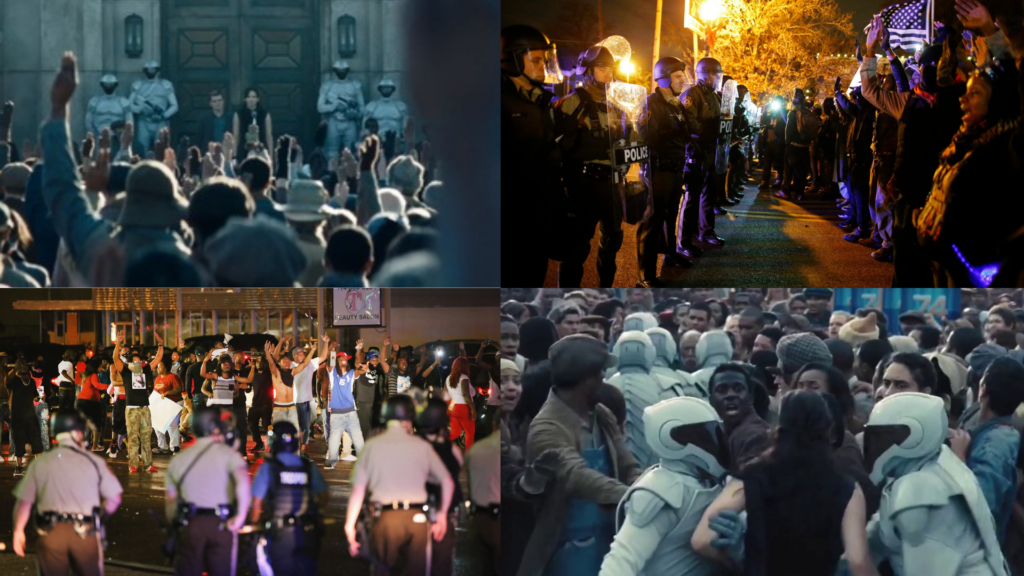
The Hunger Games series was a large part of literary and cinema culture in America when it first came out, but why was it so successful?
“The real reason ‘Hunger Games’ has captured public imagination is that its fictional world of Panem is, in so many ways, an extreme version of our own America. For those who have not seen the movies or read the books, the ‘Hunger Games’ tells the story of a young woman – Lawrence’s Katniss Everdeen – and her defiance of her society’s wealthy, exploitative ruling elite. These elite, the dastardly ‘Capitol,’ reinforce their power by making the children of oppressed regions battle to the death in what are called ‘Hunger Games'” (Jones, 2014).
“It is a far-fetched fairy tale. But if you get caught up in the details of the story, you might miss themes – crushing inequality, unaccountable governance, violence against children – that resonate with the daily lives of millions of Americans” (Jones, 2014).
Just look at the news.
“In the world of the ‘Hunger Games,’ the Capitol lives a life of extravagant wealth and consumption. Meanwhile, out in the ‘districts,’ millions of people work dangerous jobs with low pay. As the Capitol wallows in excess, the districts can barely afford to feed their children” (Jones, 2014).
“When Americans look around and see the top 25 hedge fund managers raking in $21 billion while their own paychecks get smaller and smaller, the imaginary world of Panem does not seem so far away” (Jones, 2014).
“The parallels do not stop there. Everdeen’s District 12 is a coal-mining district, feeding the rapacious energy demands of the Capitol but receiving little in return but fouled lungs and poisoned skies” (Jones, 2014).
“In the 2014 elections, polluters spent more than $100 million to buy themselves a compliant Congress” (Jones, 2014).
These parallels between our society and the book series could have been the reason the story resonated with so many. People wanted to be Katniss, and they sympathized with the districts while hating the Capitol. Do those same feelings of sympathy and resentment translate to real-life situations? And if they do, how does that change our relationship with each other and the economic governmental dynamics at play?
If we continue to parallel the Hunger Games to our society we see that “After one of that district’s children dies in the ‘Hunger Games,’ the mostly black region is the first to rise up in protest against the contest. The Capitol responds not by asking whether this cruel system makes any sense, or whether they simply erred along the way. Instead, they turn District 11 into a militarized police state” (Jones, 2014).
Sound familiar?

“Nonviolent protestors gather. Riot police stand by threateningly. Residents raise their hands in the air in a potent symbol of freedom. The police cracks down brutally” (Jones, 2014).
“The ‘Hunger Games’ is not just some liberal diatribe. It is also the story of an out-of-control state, distant and untouchable, exploiting the labor and lives of millions of citizens. Even as progressive populists see it as a cautionary tale of hoarding and excess, conservatives view the ‘Hunger Games’ as a narrative of big government run amok. We live in a time when we can all agree that our large institutions are failing us and even threatening our children. We seem so divided only because we cannot agree on which institutions are most to blame” (Jones, 2014).
So how can the concepts of story-telling and parallels help us improve these institutions and improve personal finance and wellbeing in our collective communities? Can design help us understand how fiction and reality are intertwined?
References:
Jones, V. (2014, November 21). ‘Hunger Games,’ a mirror of America’s inequality. CNN Opinion. https://www.cnn.com/2014/11/21/opinion/jones-hunger-games/index.html
Lionsgate Movies. (2011, November 14). The Hunger Games (2012 Movie) – Official Theatrical Trailer – Jennifer Lawrence & Liam Hemsworth [Video]. Youtube. https://www.youtube.com/watch?v=mfmrPu43DF8



